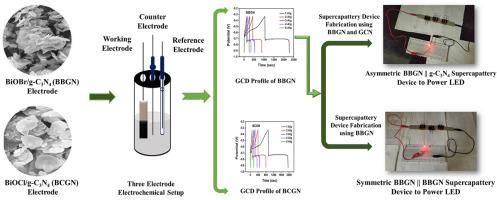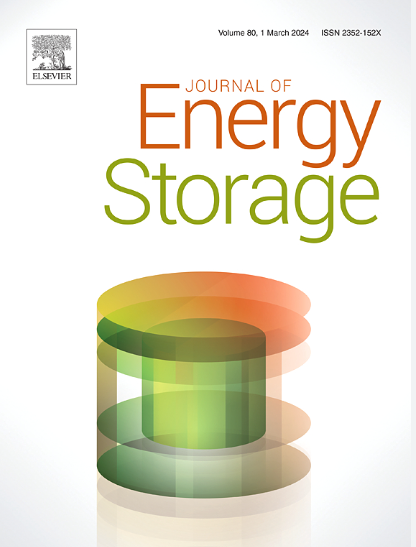Preparation and characterization of BiOBr/g-C3N4 and BiOCl/g-C3N4 electrode materials for high-performance asymmetric (BiOBr/g-C3N4||g-C3N4) and symmetric (BiOBr/g-C3N4||BiOBr/g-C3N4) supercapattery devices
IF 8.9
2区 工程技术
Q1 ENERGY & FUELS
引用次数: 0
Abstract
The drastic depletion of fossil fuels and ever increasing environmental pollution are the two key factors to search for alternative renewable energy resources. Nowadays, hybrid Electrochemical Energy Storage device (EES) known as supercapattery is considered as the prominent green energy source, because of having the merits of both supercapacitors and batteries. In the present work, two different hybrid electrode materials namely Bismuth oxybromide (BiOBr)/graphitic carbon nitride (g-C3N4) [BBGN] and Bismuth oxychloride (BiOCl)/graphitic carbon nitride (g-C3N4) [BCGN] were synthesized using a facile precipitation method where BiOBr (BB)/BiOCl (BC) was decorated at the surface of g-C3N4 (GCN). The prepared hybrid electrodes BBGN and BCGN exhibit high specific capacity of 1248.84 C/g and 1022.67 C/g at a current density of 1 A/g, compared to BB, BC and GCN electrodes. The sheet like morphology of BBGN and BCGN promotes fast ion transfer and thereby enhances the power density and energy density. The fabricated BiOBr/g-C3N4||BiOBr/g-C3N4 symmetric supercapattery (SSC) device delivered an excellent energy density of 22.5 Wh/kg than BiOBr/g-C3N4||g-C3N4 asymmetric supercapattery (ASC) device (14.76 Wh/kg). The performance of SSC device was demonstrated using a 2 V red light emitting diode (LED) and it could able to power for 5 min 35 s. Hence, these results authenticate that the BiOBr/g-C3N4 nanocomposite may serve as a promising electrode material for supercapattery applications in the realm of renewable energy.

用于高性能非对称(BiOBr/g-C3N4||g-C3N4)和对称(BiOBr/g-C3N4||BiOBr/g-C3N4)超级电池器件的 BiOBr/g-C3N4 和 BiOCl/g-C3N4 电极材料的制备与表征
化石燃料的急剧枯竭和日益加剧的环境污染是寻找替代性可再生能源的两大关键因素。如今,被称为超级电池的混合电化学储能装置(EES)因同时具有超级电容器和电池的优点而被认为是最重要的绿色能源。在本研究中,采用简易沉淀法合成了两种不同的混合电极材料,即氧溴化铋(BiOBr)/石墨氮化碳(g-C3N4)[BBGN]和氧氯化铋(BiOCl)/石墨氮化碳(g-C3N4)[BCGN],其中 BiOBr (BB)/BiOCl (BC) 被装饰在 g-C3N4 (GCN) 表面。与 BB、BC 和 GCN 电极相比,制备的混合电极 BBGN 和 BCGN 在电流密度为 1 A/g 时的比容量分别为 1248.84 C/g 和 1022.67 C/g。BBGN 和 BCGN 的片状形态促进了离子的快速转移,从而提高了功率密度和能量密度。与 BiOBr/g-C3N4||g-C3N4 不对称超级电池(ASC)器件(14.76 Wh/kg)相比,制备的 BiOBr/g-C3N4||BiOBr/g-C3N4 对称超级电池(SSC)器件的能量密度高达 22.5 Wh/kg。因此,这些结果证明,BiOBr/g-C3N4 纳米复合材料可以作为一种很有前途的电极材料,应用于可再生能源领域的超级电池。
本文章由计算机程序翻译,如有差异,请以英文原文为准。
求助全文
约1分钟内获得全文
求助全文
来源期刊

Journal of energy storage
Energy-Renewable Energy, Sustainability and the Environment
CiteScore
11.80
自引率
24.50%
发文量
2262
审稿时长
69 days
期刊介绍:
Journal of energy storage focusses on all aspects of energy storage, in particular systems integration, electric grid integration, modelling and analysis, novel energy storage technologies, sizing and management strategies, business models for operation of storage systems and energy storage developments worldwide.
 求助内容:
求助内容: 应助结果提醒方式:
应助结果提醒方式:


